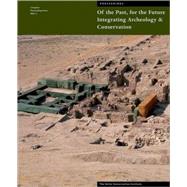
| Looking forward, not backward : archaeology and the future of the past | p. 7 |
| The monumental and the trace : archaeological conservation and the materiality of the past | p. 13 |
| Introduction | p. 21 |
| Ideology, economics, and site management | p. 23 |
| NGO and government collaboration in archaeological site management : the case of Petra, Jordan | p. 29 |
| Privatization of state-owned cultural heritage : a critique of recent trends in Europe | p. 35 |
| Regional site management planning and training : the SPAFA example in Southeast Asia | p. 40 |
| Interpretation as preservation : rationale, tools, and challenges | p. 43 |
| Preservation of heritage sites in the Caribbean : the experience of the Brimstone Hill Fortress National Park of St. Kitts and Nevis | p. 47 |
| Introduction | p. 53 |
| Making archaeological sites : conservation as interpretation of an excavated past | p. 55 |
| Decision making for conservation of archaeological sites : the example of the Laetoli Hominid Trackway, Tanzania | p. 64 |
| Conservation qua archaeology at Tell Mozan/Urkesh | p. 73 |
| Introduction | p. 85 |
| Conservation, researchers, and Aboriginal heritage : a perspective from coastal Southeastern Australia | p. 87 |
| "It will always be set in your heart" : archaeology and community values at the Former Dennawan Reserve, Northwestern New South Wales, Australia | p. 94 |
| Community-based archaeological resource management in Southeast Asia | p. 102 |
| Adaptive management and the community at El Pilar : a philosophy of resilience for the Maya Forest | p. 105 |
| Social landscapes and archaeological heritage in Latin America | p. 113 |
| Reflections on archaeological heritage and indigenous peoples in Chile | p. 125 |
| Whose archaeology? : social considerations in archaeological research design | p. 131 |
| Changing stakeholders and community attitudes in the Coa Valley World Heritage Site, Portugal | p. 136 |
| Introduction | p. 145 |
| Sustainable tourism at archaeological world heritage sites | p. 148 |
| Presentation and interpretation of archaeological sites : the case of Tell Mozan, Ancient Urkesh | p. 152 |
| Are we ready to learn? : lessons from the South Asian region | p. 157 |
| Monitoring of landscape change at world heritage sites : prologue to proactive management | p. 163 |
| Introduction | p. 175 |
| The new Museum of Altamira : finding solutions to tourism pressure | p. 177 |
| Archaeology and sustainable tourism in Egypt : protecting community, antiquities, and environment | p. 184 |
| Maya cities and tourism | p. 191 |
| Tourism and cultural risk management | p. 194 |
| Introduction | p. 201 |
| Archaeological collections : valuing and managing an emerging frontier | p. 204 |
| Archaeological archives in Britain and the development of the London Archaeological Archive and Research Centre | p. 211 |
| Working with Native communities and the collections of the National Museum of the American Indian : theory and practice | p. 216 |
| Challenges in conserving archaeological collections | p. 220 |
| Archaeological conservation in Turkey | p. 224 |
| Introduction | p. 231 |
| The law as a tool for cultural heritage preservation : the case of Iraq and Afghanistan | p. 234 |
| Babylon : a case study in the military occupation of an archaeological site | p. 240 |
| The National Museum and archaeology in Afghanistan : accomplishments and current needs | p. 247 |
| Preserving the cultural and national heritage of Afghanistan | p. 251 |
| UNESCO's mandate and activities for the rehabilitation of Afghanistan's cultural heritage | p. 258 |
| Recovery from cultural disaster : strategies, funding, and modalities of action of international cooperation in Afghanistan | p. 263 |
| Preserving Afghanistan's cultural heritage : what is to be done? | p. 266 |
| Introduction | p. 275 |
| China's legal framework for the protection of its material cultural heritage | p. 278 |
| Archaeology, cultural heritage protection, and capital construction in China | p. 282 |
| Planning for conservation of China's prehistoric sites : the Liangzhu site case study | p. 286 |
| Conservation during excavation : the current situation in China | p. 291 |
| Heritage protection in the Liyie Basin, Hunan Province, the People's Republic of China | p. 294 |
| The conservation and presentation of large-scale archaeological sites in Liaoning, China | p. 298 |
| Introduction | p. 305 |
| Sharing resources : issues in regional archaeological conservation strategies in Southern Africa | p. 306 |
| Intangible heritage management : does world heritage listing help? | p. 312 |
| Rock art tourism in Southern Africa : problems, possibilities, and poverty relief | p. 322 |
| Rock art management in Eastern and Southern Africa : whose responsibility? | p. 331 |
| Building the capacity to protect rock art heritage in rural communities | p. 336 |
| Conservation of non-western rock art sites using a holistic medical approach | p. 340 |
| Why "conserve"? : situating Southern African rock art in the here and now | p. 346 |
| Table of Contents provided by Blackwell. All Rights Reserved. |
The New copy of this book will include any supplemental materials advertised. Please check the title of the book to determine if it should include any access cards, study guides, lab manuals, CDs, etc.
The Used, Rental and eBook copies of this book are not guaranteed to include any supplemental materials. Typically, only the book itself is included. This is true even if the title states it includes any access cards, study guides, lab manuals, CDs, etc.